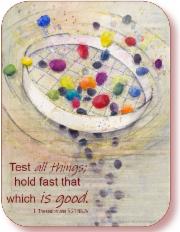The Watchword 2024

The apostle Paul writes a letter to the young church he has founded in Thessalonica. He is worried because it is exposed to many influences and hostilities:
We make decisions every day. Smaller ones mostly unconsciously, larger ones only after careful consideration. And yet there is often a residue of uncertainty. We don't always recognise whether a decision was right or wrong. Besides, it's also a matter of opinion, isn't it? I can't and don't want to simply adopt for myself what others think is right and good. This means that my views, my beliefs and the way I live them are constantly being put to the test. By myself and by others. Also by God, who is concerned that my faith and my relationship with him do not become rigid, but remain alive. And there is always the question of what cannot be undone, of the reliable foundation that gives me stability. In life and in death. Could this be exactly what St Paul meant when he said ‘Test all things; hold fast that which is good’?
The artist Stefanie Bahlinger compares this testing process to a sieving process. Some stones lie on the sieve bottom, others have fallen through. Some shimmer like precious stones; many of the greyish black ones have already fallen through the sieve.
‘Test all things; hold fast that which is good.’means not being afraid of the new and unfamiliar, only to let it fall through the cracks too quickly. It encourages us to look at everything first, scrutinise it carefully and remain in dialogue with one another. Immediately before ‘Test all things; hold fast that which is good’, Paul writes:
See that no one renders evil for evil to anyone, but always pursue what is good both for yourselves and for all. Rejoice always, pray without ceasing, in everything give thanks; for this is the will of God in Christ Jesus for you. Do not quench the Spirit. Do not despise prophecies. Test all things; hold fast that which is good. (1 Thessalonians 5:15–20)
Seen in this light, ‘‘Test all things; hold fast that which is good.’can mean asking God's will again and again, allowing ourselves to be moulded and guided by it. It is usually not as simple as in the diagram, where gemstones stand out clearly from the others. Paul mentions some behaviours that correspond to God's will and serve the good. The coloured gemstones can mean different things. Some: Do not repay in kind if you think that someone is trying to harm you. Dare to take the first step out of the destructive vicious circle. Others: Bless those who put obstacles in your way and grant them good things. Still others: Radiate joy and confidence where courage and hope are sinking. Being a Christian does not mean painting and seeing everything in black. Then there are those for prayer: There is nothing that you cannot bring before God. At any time, day or night. And finally: realise that you are the recipients of gifts and that you are not neglected.
Why is it so much easier to talk about shortcomings than good things? Why do negative things stick more than positive things? Perhaps that is why we find the call to be thankful so often in the Bible. Psalms also invite us to pray along with them when we only see the black and lack the right words. The Holy Spirit gives us these words if we give him space in our lives. He is the driving, sorting and purifying force that brings movement into the picture, indicated by the circles around the sieve.
A golden cross stretches around it. That is the point. Not about the shape, size, composition of the sieve or the density of the grid base. These are as different as the people themselves. The cross makes the difference. Is it visible in our lives? Which doesn't mean that we have to shine and be perfect. ‘Test all things; hold fast that which is good.’ has nothing to do with self-optimisation and a life secured on all sides. God's spirit makes us alive and gives us the freedom to discover where our place is, where we need to take responsibility and where there are adjustments in our lives that need to be made. Trusting that Jesus stands by us and becomes visible through us even when we make wrong decisions or fail to provide answers. Even when we forget him on some of our journeys or do not expect him to guide us and want the best for us.
‘Test everything and keep what is good!’ I want those around me to experience my Christianity in such a way that my faith is never finished, but remains alive. By constantly giving me room to manoeuvre, I rediscover new and old things and dare to question rigid positions. I want to share this with others and stay in dialogue with them about how and why I have made and continue to make one decision or another. Above all, I want them to discover for themselves that faith provides support in life and in death.
In the graphic, the broken golden lines lead to a crown that God has in store for all those who entrust themselves to him. Couldn't the crown also be an indication that, in the end, examining and keeping what is good is about the question: does it serve to give God alone the honour?
Interpretation text
Renate Karnstein